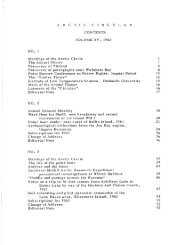Volume 11, 1958 - The Arctic Circle - Home
Volume 11, 1958 - The Arctic Circle - Home
Volume 11, 1958 - The Arctic Circle - Home
You also want an ePaper? Increase the reach of your titles
YUMPU automatically turns print PDFs into web optimized ePapers that Google loves.
VOL. XI No.2 THE ARCTIC CIRCULAR 28<br />
A final sledge trip was made between June 15 and June 20<br />
to Parry Bay.A supply of gasoline was cached near. the western end<br />
of the bay and a reconnaissance trip carried out in the country west of<br />
Amitioke Peninsula. Following a visit to the Eskimo camp at<br />
"Tikerak" we returned to Hall Lake by way of South Ooglit ISland,<br />
where Arthur Mansfield and Dan Perey of the Fisheries Res earch<br />
Board <strong>Arctic</strong> Unit were working. Travelling conditions. excellent<br />
during the previous month, deteriorated rapidly after June 20.<br />
Owing to melt-water on the sea ice no more sledge journeys were<br />
made, though they would have been possible for several additional<br />
weeks. During this first phase we had reconnoitred much of the<br />
northeastern coast of Melville Peninsula and visited all the Eskimo<br />
camps there.<br />
By the end of June melting of the snow allowed more<br />
detailed geomorphological studies. On June 26 we were flown to the<br />
west coast of Melville Peninsula where a comprehensive study of<br />
the south part of Garry Bay was carried out before returning to our<br />
bas e camp on July 3.<br />
On July 8 we left our camp on foot on an extended trip to<br />
the interior of the peninsula west of Hall Lake. Walking was difficult<br />
across the swampy lowland east of the lake but much easier on the<br />
higher land to the north and west. On July 10 we reached the cache<br />
which had been established by air and during the next ten days we<br />
made geomorphological studies along the contact zone between the<br />
Palaeozoic sediments of the eastern lowland and the Precambrian<br />
crystallines of the interior. We also investigated the limits of<br />
marine submergence. Weather conditions were very nearly perfect;<br />
warm sunny days occurred with pleasing regularity and mosquitoes<br />
became a nuisance only after July 16. On the return trip walking<br />
was easier as the lowland was much drier. We reached our base<br />
on July 19 after covering a distance of approximately 175 miles in<br />
twelve days.<br />
On July 25 we flew to Sarcpa Lake in the centre of<br />
Melville Peninsula. Here we made a number of one-day traverses<br />
and took some soundings of the lake. <strong>The</strong> greatest depth found was<br />
66 feet. On July 29 we walked to the west shore of Hall Lake at<br />
the mouth of the"Kingora River". We had planned to use the<br />
collapsible canoe we had cached there to travel around the shores<br />
of Hall Lake and if possible to ascend the two larger streams<br />
entering on its western side. Unfortunately, even at this late<br />
date the lake ice was almost solid. and the narrow shore channel<br />
was closed in many places by a steady east wind, so we had to












